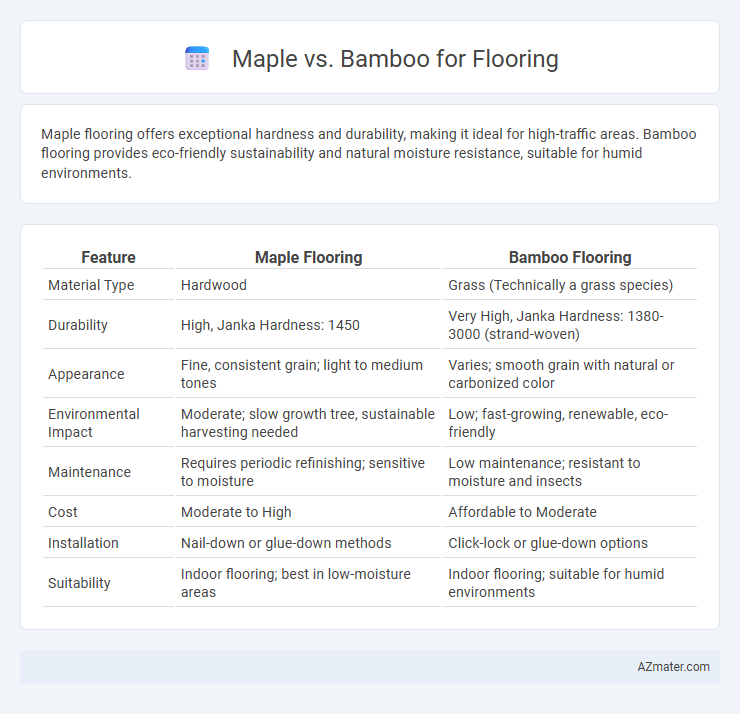Maple flooring offers exceptional hardness and durability, making it ideal for high-traffic areas. Bamboo flooring provides eco-friendly sustainability and natural moisture resistance, suitable for humid environments.
Table of Comparison
| Feature | Maple Flooring | Bamboo Flooring |
|---|---|---|
| Material Type | Hardwood | Grass (Technically a grass species) |
| Durability | High, Janka Hardness: 1450 | Very High, Janka Hardness: 1380-3000 (strand-woven) |
| Appearance | Fine, consistent grain; light to medium tones | Varies; smooth grain with natural or carbonized color |
| Environmental Impact | Moderate; slow growth tree, sustainable harvesting needed | Low; fast-growing, renewable, eco-friendly |
| Maintenance | Requires periodic refinishing; sensitive to moisture | Low maintenance; resistant to moisture and insects |
| Cost | Moderate to High | Affordable to Moderate |
| Installation | Nail-down or glue-down methods | Click-lock or glue-down options |
| Suitability | Indoor flooring; best in low-moisture areas | Indoor flooring; suitable for humid environments |
Introduction to Maple and Bamboo Flooring
Maple flooring is renowned for its durability, fine grain, and light, creamy color that enhances both traditional and modern interiors. Bamboo flooring, derived from a rapidly renewable grass, offers eco-friendly benefits, high hardness, and natural resistance to moisture and pests. Both options provide versatile aesthetics and sustainable choices, but their distinct material properties influence installation, maintenance, and longevity.
Key Differences Between Maple and Bamboo
Maple flooring is a hardwood derived from the Acer genus, known for its dense grain, natural stiffness, and durability, ideal for high-traffic areas, while bamboo is a grass species that offers a more sustainable and eco-friendly option with rapid growth and regenerative properties. Maple typically presents a fine, uniform texture in light creamy tones, whereas bamboo showcases a natural, varied grain pattern with colors ranging from pale yellow to rich amber, influenced by the carbonization process. Maintenance for maple requires periodic refinishing to preserve its smooth surface, contrasting with bamboo's resilience to moisture and scratches, although it can be more susceptible to humidity-induced warping without proper installation.
Durability Comparison: Maple vs. Bamboo Floors
Maple floors offer exceptional hardness, ranking around 1450 on the Janka hardness scale, making them highly resistant to dents and scratches. Bamboo flooring, particularly strand-woven bamboo, can surpass maple's durability with a Janka rating up to 3000, providing superior impact resistance and longevity. Both materials are durable, but strand-woven bamboo is often preferred for high-traffic areas due to its impressive hardness and environmental sustainability.
Aesthetic Appeal and Design Versatility
Maple flooring offers a smooth, fine grain with a light, uniform color palette that enhances modern and traditional interiors, providing a timeless aesthetic appeal. Bamboo flooring presents a unique, natural striped pattern and rich tonal variations, making it highly versatile for eclectic and contemporary designs while adding an eco-friendly edge. Both materials allow customization through staining and finishing, but bamboo's sustainability and exotic look often appeal to designers seeking bold, environmentally conscious statements.
Sustainability and Environmental Impact
Maple flooring derives from hardwood trees known for rapid growth in temperate regions, making it a relatively sustainable option due to its widespread availability and efficient harvesting cycles. Bamboo flooring, despite technically being a grass, surpasses many hardwoods in sustainability with its rapid renewability and minimal need for pesticides or fertilizers, significantly reducing environmental impact. Both materials offer eco-friendly flooring solutions, but bamboo's faster growth rate and carbon sequestration potential often position it as the more environmentally responsible choice.
Installation Process and Maintenance Needs
Maple flooring requires precise acclimation and professional-grade adhesives for installation, ensuring stability and preventing cupping or warping. Bamboo flooring offers a more straightforward installation, often using click-lock systems suitable for DIY projects, with less sensitivity to humidity changes. Maintenance for maple involves regular polishing to maintain its glossy finish, while bamboo demands routine cleaning and occasional refinishing to preserve its hardness and color resilience.
Cost and Value for Money
Maple flooring typically costs between $5 and $10 per square foot, offering a durable hardwood option with a consistent grain that adds long-term value to homes. Bamboo flooring ranges from $3 to $8 per square foot and provides an eco-friendly alternative that is both affordable and resilient, often outperforming traditional hardwoods in moisture resistance. Choosing between maple and bamboo depends on balancing initial cost with durability and environmental impact, where bamboo generally delivers better value for money in budget-conscious projects.
Suitability for High-Traffic Areas
Maple flooring offers exceptional hardness with a Janka rating around 1,450, making it highly resistant to dents and wear in high-traffic areas. Bamboo flooring, especially strand-woven varieties with Janka ratings exceeding 3,000, provides superior durability and resilience suited for commercial or busy residential spaces. Both materials perform well under heavy foot traffic, but strand-woven bamboo often outlasts traditional hardwoods like maple in extreme usage environments.
Allergens and Indoor Air Quality
Maple flooring, known for its dense grain and natural hardness, tends to trap fewer allergens like dust and pet dander compared to bamboo, which can sometimes have a more porous surface depending on its manufacturing process. Both maple and bamboo are sustainable choices, but maple's low VOC emissions contribute positively to maintaining indoor air quality, reducing the risk of respiratory irritants commonly found in flooring materials. Choosing high-quality, formaldehyde-free finishes for either wood further enhances allergen control and supports healthier indoor environments.
Maple vs. Bamboo: Which Flooring is Right for You?
Maple flooring offers exceptional hardness and durability, making it ideal for high-traffic areas and long-lasting wear, while bamboo provides a sustainable, eco-friendly option with impressive tensile strength and natural resistance to moisture. Maple's classic grain patterns and ability to take stains well cater to traditional and contemporary design preferences, whereas bamboo's rapid renewability and unique aesthetics appeal to environmentally conscious homeowners seeking distinctive styles. Considering factors such as budget, maintenance, environmental impact, and design goals will help determine whether maple or bamboo flooring aligns best with your specific needs and lifestyle.

Infographic: Maple vs Bamboo for Flooring
 azmater.com
azmater.com